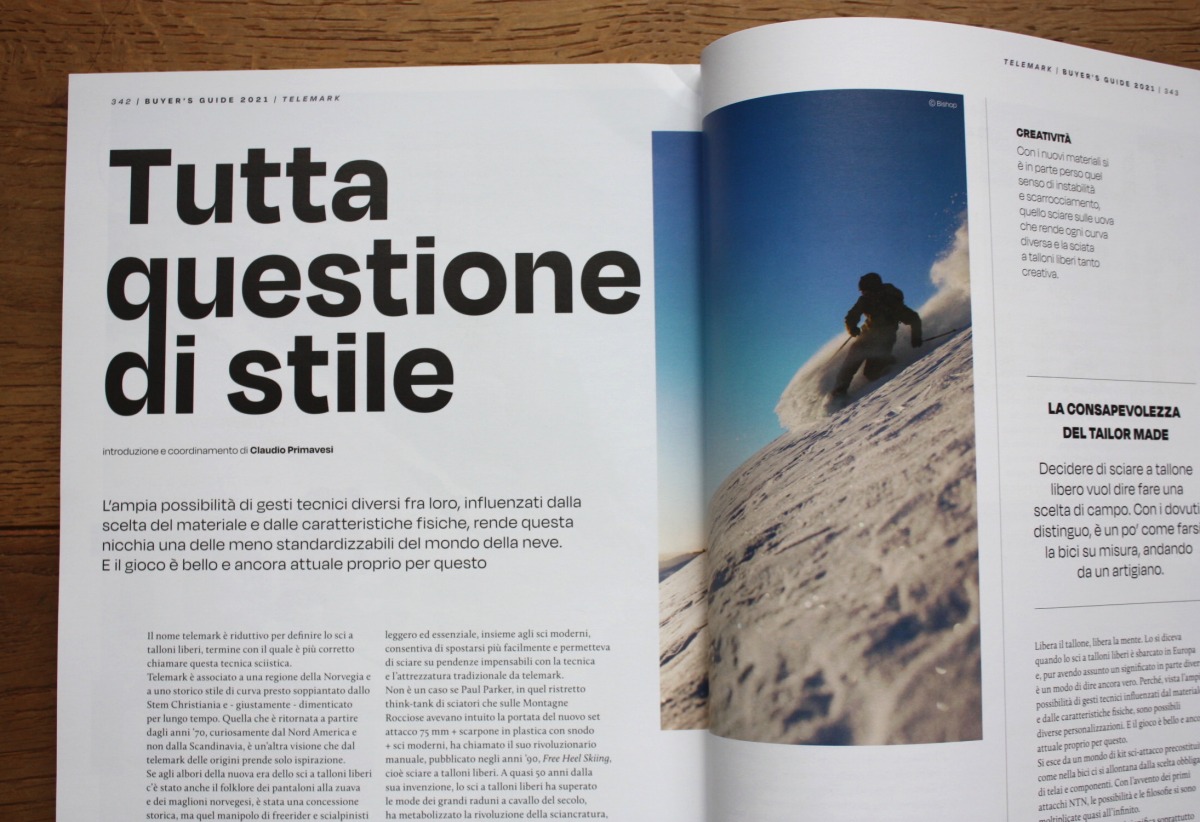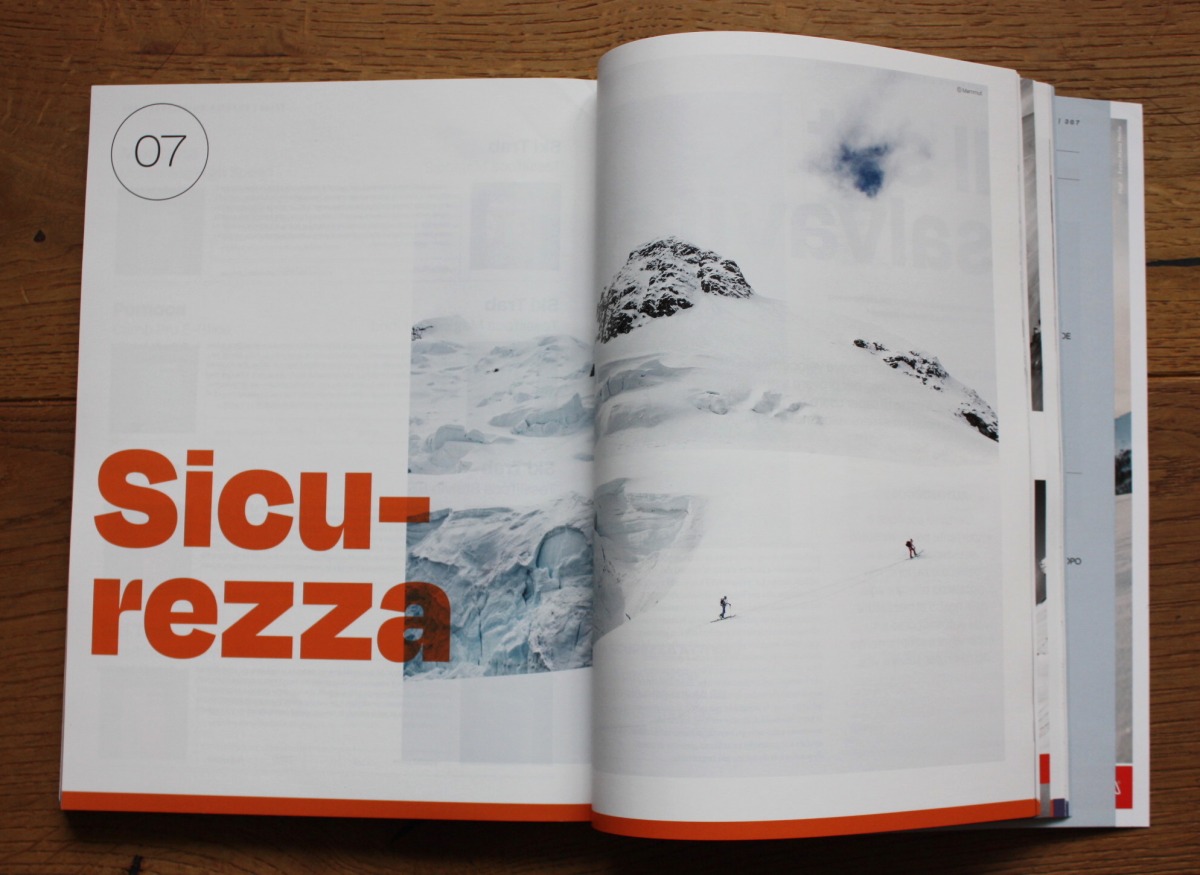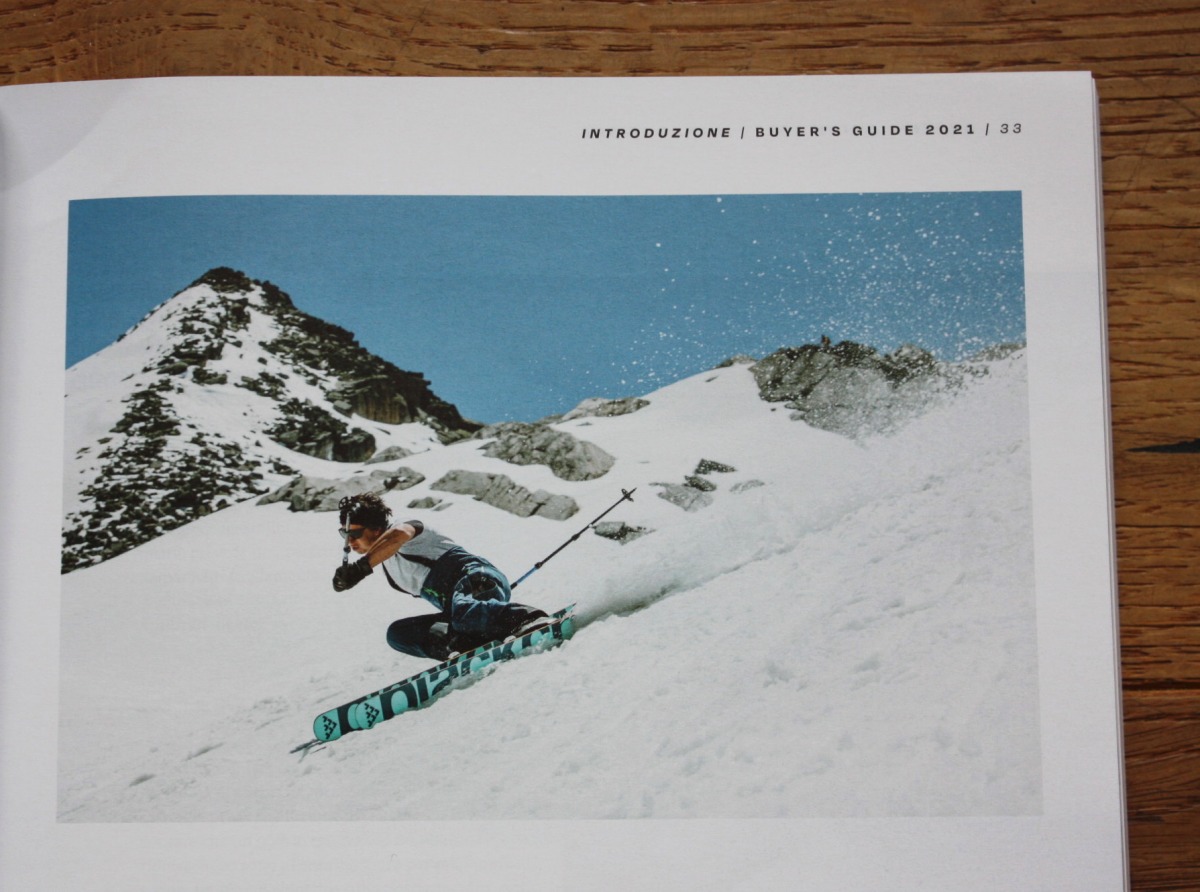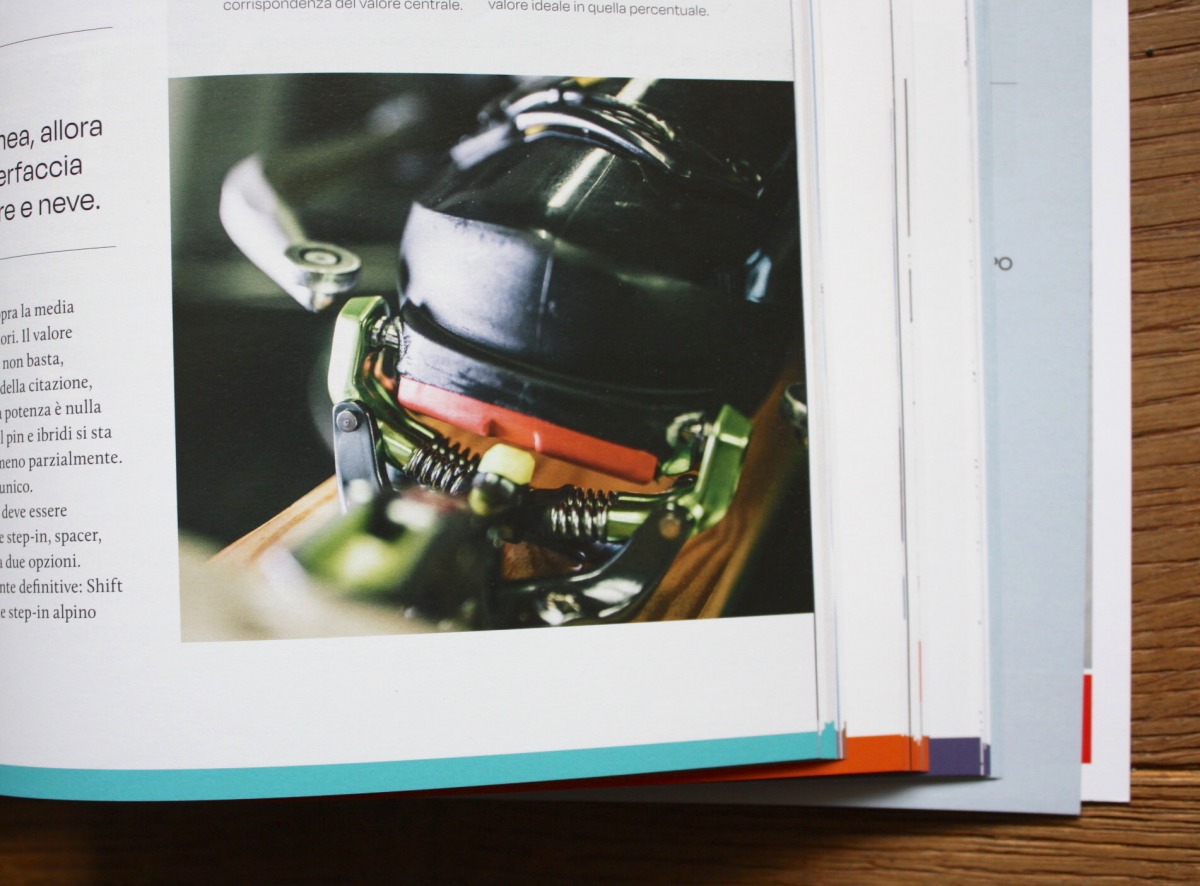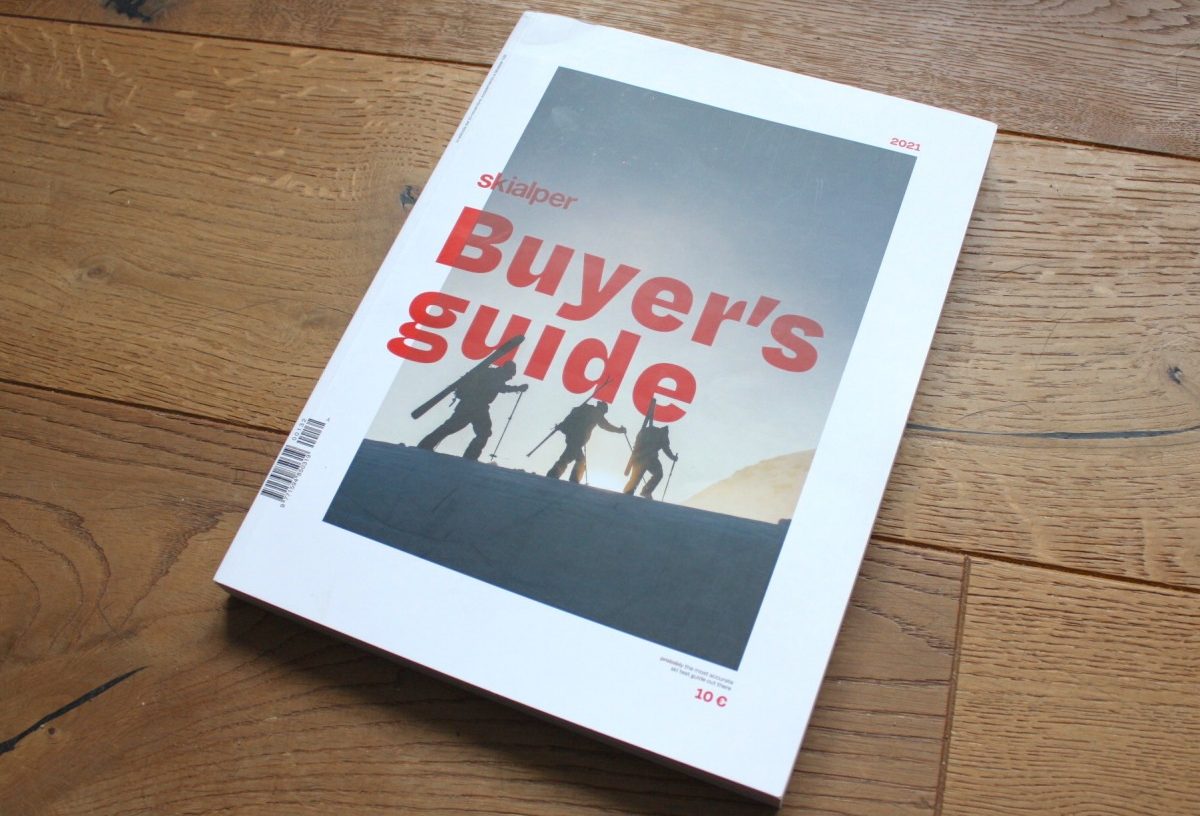
The 2021 Skialper Buyer’s Guide, 368 pages of winter reading, filled with your favorite gear, fantastic photographs. Available only in Italian–the language of skiing is universal.
Written by Bruno Schull
It’s here! For the second (or third?) year in a row, it falls to me to announce that the new Skialper Buyer’s Guide has been released. For the uninitiated, the Skialper Buyer’s Guide is arguably the best ski touring gear guide on the planet, full of essays, thoughts, new and old perspectives, amazing photographs, ingenious testing methods, and, of course, meticulous reviews of touring skis, boots, and bindings, all delivered with a distinctive European flair. See the following points for a quick review of this year’s edition.
Note: Skialper is an Italy-based magazine dedicated to trail running,back country ski touring, skimo racing, and mountain culture. It’s produced by Mulatero Editore , a publishing house located in Turin, in Northern Italy, not far from the Italian Alps. WildSnow has been covering the Skialper Buyer’s Guide for years now. Check out our previous content.)
Kudos on delivery
First, considering the worldwide effects of the pandemic, and the particularly difficult conditions in northern Italy, the Skialper team deserves enormous credit for making this happen, to say nothing of creating, under these circumstances, an amazing publication. Their work is a testimony to their passion and dedication. Huge respect, and a heartfelt Grazie to the Skialper team. This is just what we needed in dark times!
Contents have shifted slightly
Bearing in mind the above, I don’t think it takes anything away from the guide to admit that it’s somewhat slimmer than other years. It’s not quite as long overall, and there aren’t quite as many reviews of skis, boots, and bindings. Unfortunately, some sections from previous years, such as the innovative boot flex tests, and women’s specific skis, were not included. At the same time, avalanche equipment, including beacons, probes, and shovel, are reviewed, a welcome addition. Overall, the guide feels more condensed, although, rest assured, the customary depth and detail are present.
Freeing the heel
Telemark gear. Did you read that correctly? Yes! Despite the difficult circumstances, the guide explores modern telemark culture in Europe (who knew?) and presents a variety of related gear, including some very special skis. The telemark section opens with the title, “Tutta questione de stile,” or, “It’s all a question of style.” Indeed.
No speak Italian, no problem
In various years, the guide has been available in print, online, and in Italian and English. This year, it’s only available in print, and only in Italian. This will certainly dissuade some customers, especially English-speaking customers, but I still think it’s an amazing resource. As a reader with only limited knowledge of Italian, I can report that the core content of the reviews is comprehensible, especially with the many charts, graphics, and numerical data. Also, with some leeway for creative interpretation, and a Google search for a word or two, I find myself able to understand most of the text, especially as the context is familiar. In short, if you are at all curious, don’t let the Italian prevent you from ordering a copy. And the production values of the print edition are, as always, superb. The photographs, for example, are amazing.
Glory shots, ski touring style
More about the photographs. Perhaps because of the smaller number of reviews this year, I detect somewhat more “filler” material, composed of shots of the Skialper team skinning toward summits, ripping turns, or just hanging out on the slopes. This is fine, and I guess if I was as stylish, good-looking, and all-around cool as the folks at Skialper, I’d want my pictures in print too! It does bring to a wider audience a particular European mountain scene, but it might be off-putting to some. I suppose it’s like an American ski magazine full of pictures of young dudes in baggy pants doing rail slides in the fun park — nothing wrong with that, but maybe not what you’re looking for in your ski touring guide.
That said, there are some astonishing photographs. You’ve seen pictures of alpine racers achieving seemingly-impossible edge angles on hard, blue, ice-injected downhill courses. Impressive, but have you seen Skialper testers doing the same? Not only are they dragging their hips, but their elbows, wrists and torsos, their bodies inclined so much it appears they’re lying down on the snow, while wearing T-shirts and wide smiles. Of course, they’re equipped with touring gear and 120mm underfoot powder skis, carving on variable backcountry snow, between rock bands.
Boot tune tutorial
Boots. Tecnica Zero G Tune up Kit. A collaboration between Skialper and Tecnica, consisting of a new liner, foot bed, and elastic booster strap, available through select suppliers in Italy. Could this be the must-have accessory for the season?
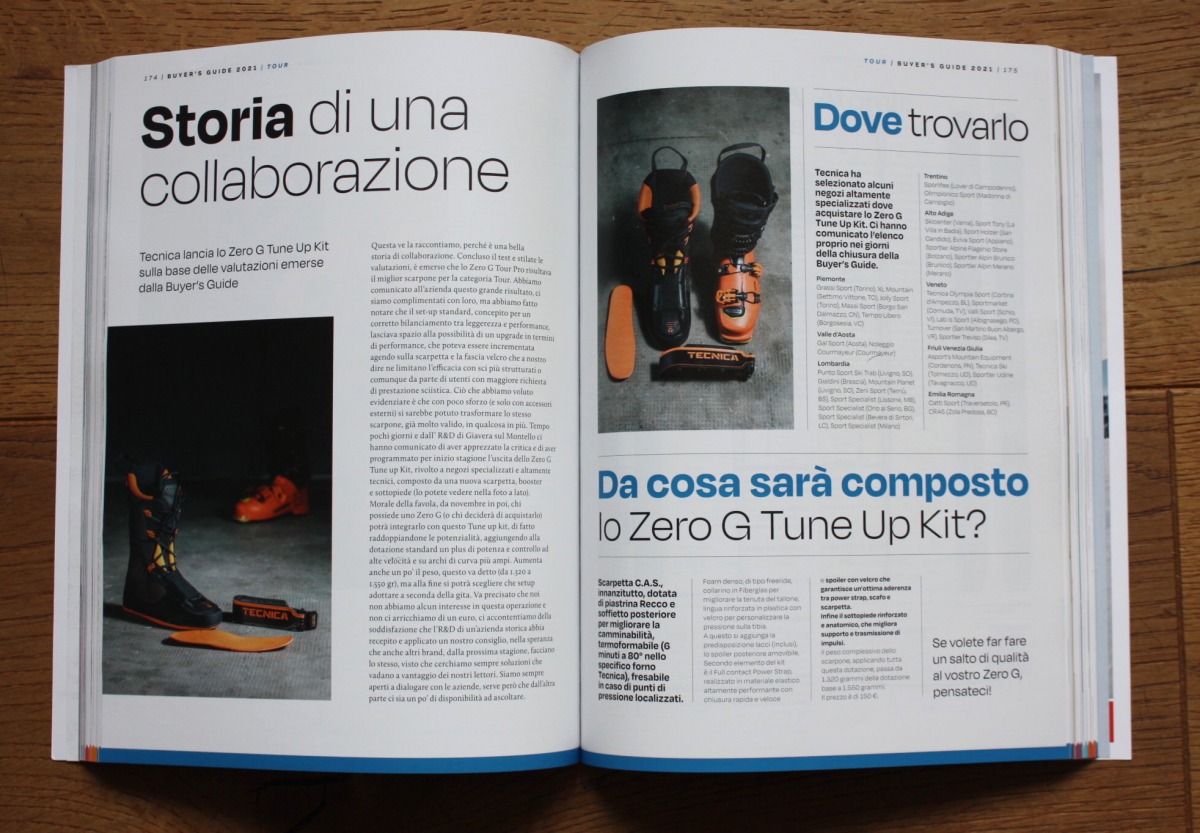
How do you make one of the best boots on the market ever better? With the Tecnica Zero G Tune up Guide, of course. A collaboration between Skialper and Tecnica.
The deepest binding tests
Bindings. Here’s where things get interesting. Something I’ve always appreciated about Skialper is the detailed binding analysis, especially the retention/release value testing. To my knowledge, Skialper offers the most extensive, consistent, reliable data about touring binding retention/release available to consumers. And they continue to improve every year.
For example, they’ve always tested bindings with a variety of different pin configurations, such as Master fit, Quick Step, Atomic/Salomon, and La Sportiva. Now that there are several alpine-touring hybrid bindings on the market, they test these bindings with both conventional and Grip Walk soles. This is an important change from last year, because testing these bindings for conventional pin retention/release is of limited value (only for the way up) and because the interaction between boot sole and binding is critical to function. The results of these tests are revealing.
To return to conventional pin bindings, for the second year in a row only one binding exhibits consistent, within-range, retention/release values across several pin configurations. I would argue that this binding is the most accommodating of variation, and therefore offers the most reliable retention and release in backcountry conditions, of all the pin bindings on the market. There’s a lot to digest about these retention/release values and what they mean for consumers, and I’m happy to dive into details in the comments if people are interested.
Reader views on ski touring
Last year, Lou presented the results of a Skialper survey in which readers responded to diverse questions about ski touring habits and preferences. This year, Skialper repeated the survey, with a new set of questions. I found one question especially relevant: “Given the developments in the Covid-19 situation, have you thought about inviting friends or acquaintances who normally ski at resorts to try on skins?” The answers to that question might determine the direction of ski touring in the future all around the world, from the Dolomites to the Rockies.
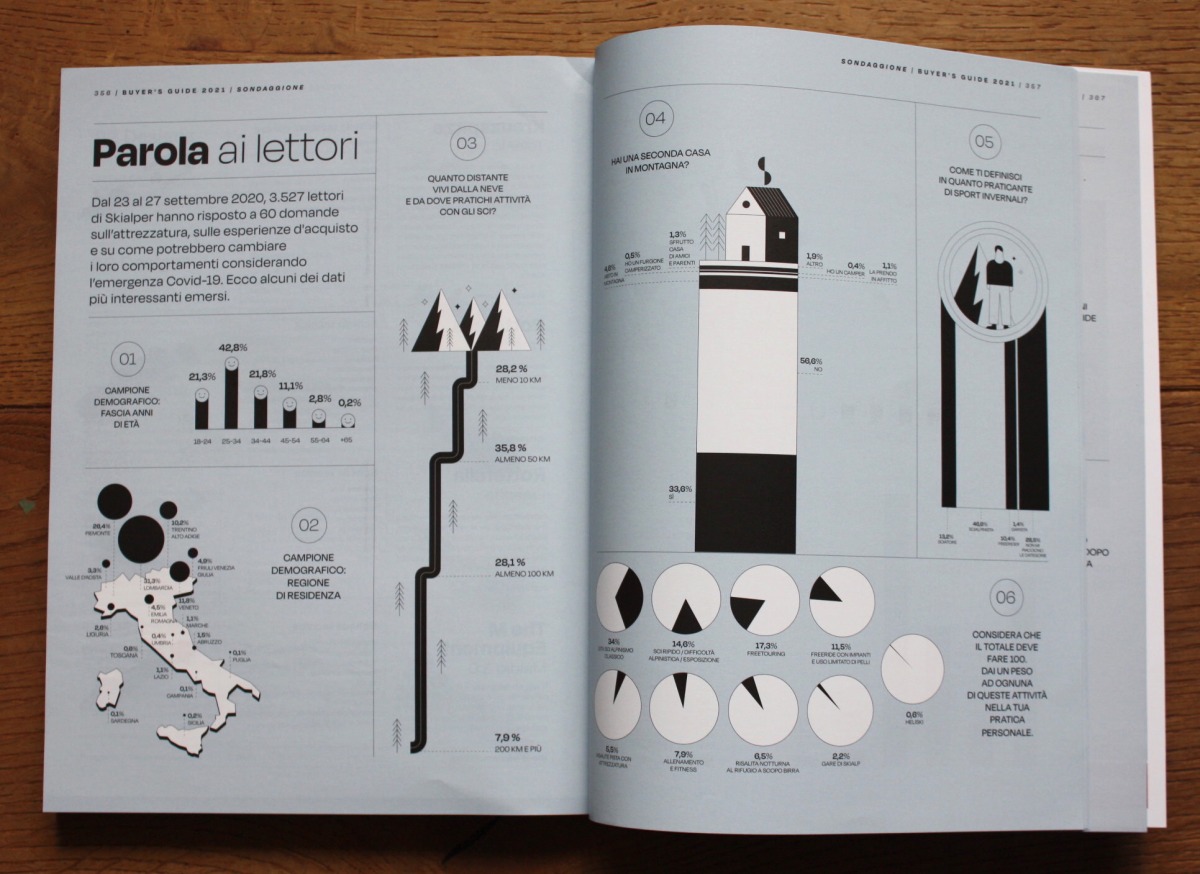
3,527 readers, 60 questions, and a very interesting set of infographics. How does a Skialper reader compare to a powder-seeker in Colorado?
I highly recommend the Skialper Buyer’s Guide. It’s a learning resource, as much as, or more than, a simple guide for material consumption. And that’s probably the highest praise for a buyer’s guide that I can offer. All the best for the holiday season.
The 2021 edition is now available for purchase here
Despite his very Italian-sounding name, Bruno Schull is an American living in Switzerland, where he teaches high school science, and tries to keep up with his 12 year-old daughter on the ski slopes. Occasionally, he can be found on touring skis, teetering beneath a heavy pack, returning from ice and alpine climbs in the Alps. A decidedly mediocre skier, Bruno is humbled and honored to have his words appear on WildSnow.
Beyond our regular guest bloggers who have their own profiles, some of our one-timers end up being categorized under this generic profile. Once they do a few posts, we build a category. In any case, we sure appreciate ALL the WildSnow guest bloggers!

